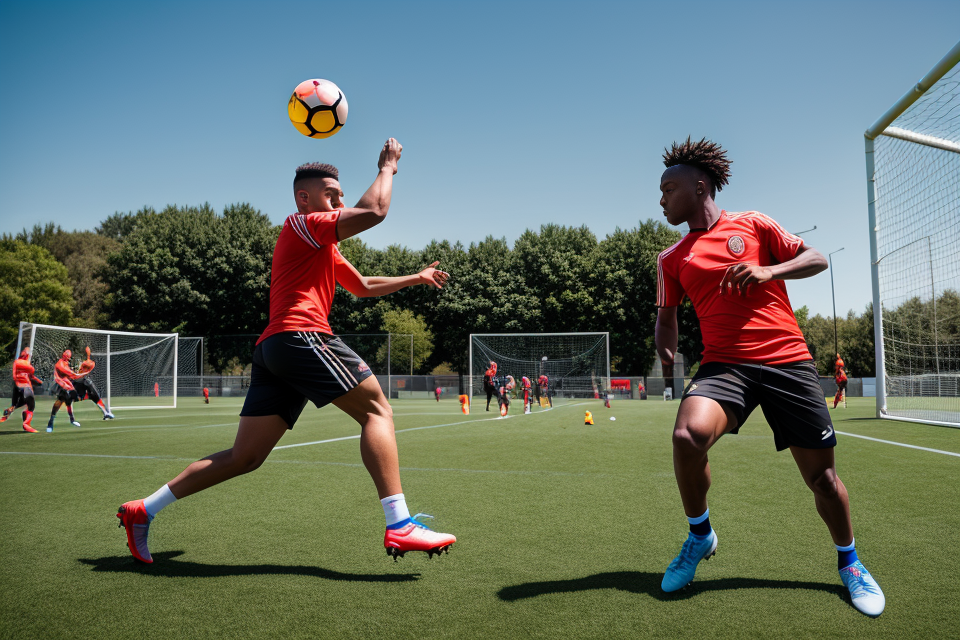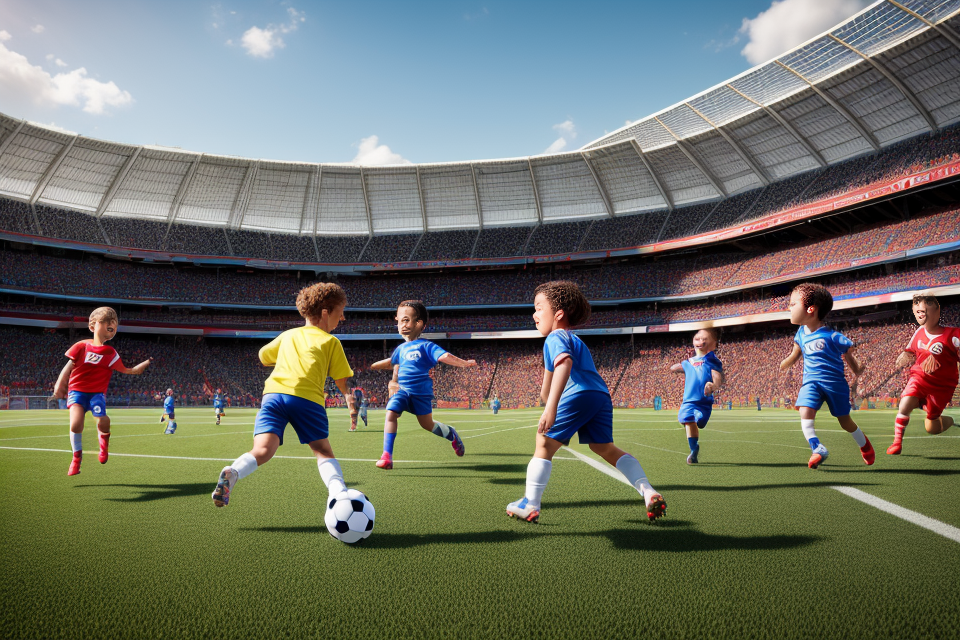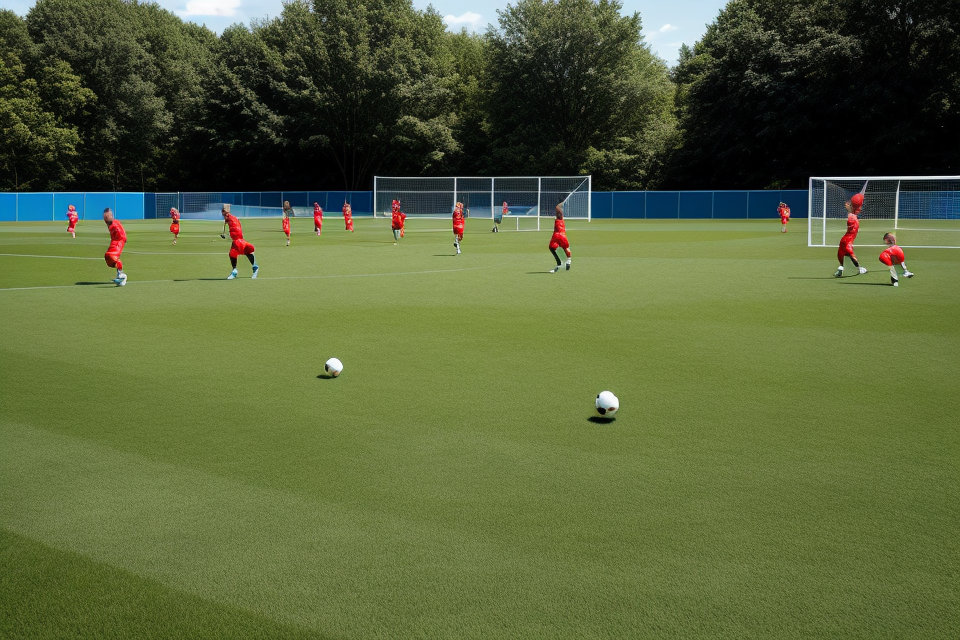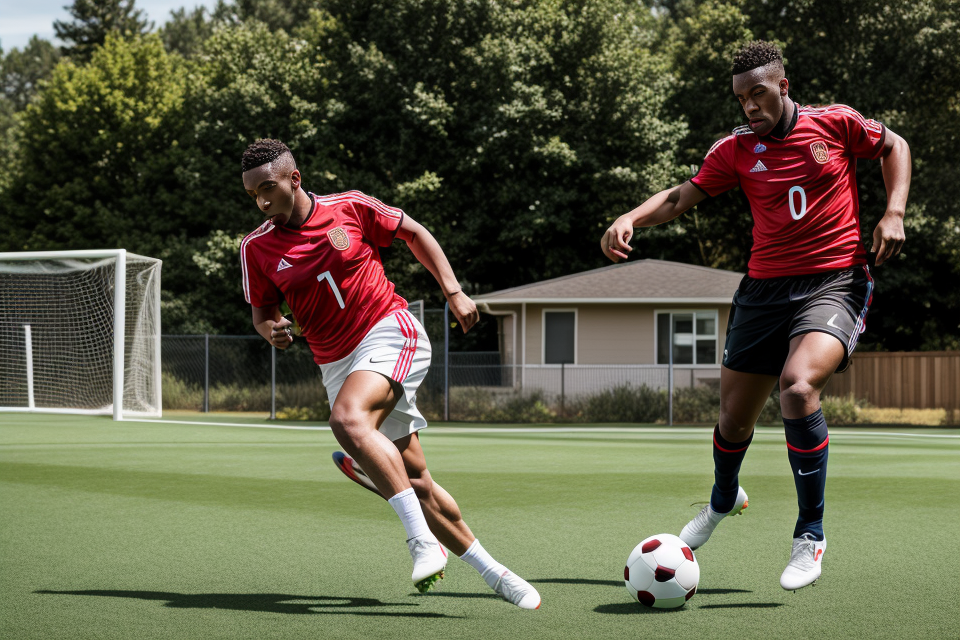Are you looking to improve your soccer skills but don’t have access to a team or a partner to practice with? Don’t worry, there are still ways to hone your abilities on the field. In this article, we will explore how to drill soccer with cones solo. This method is not only effective, but it’s also fun and engaging. With a little bit of creativity and patience, you can use cone drills to work on your ball control, dribbling, passing, and more. Get ready to take your soccer game to the next level!
Why Cone Drills are Essential for Soccer Players
The Benefits of Cone Drills
Cone drills are a fundamental aspect of soccer training that can greatly improve a player’s skills. These drills are designed to help players develop essential skills such as ball control, footwork, speed, agility, and reaction time. Here’s a closer look at the benefits of cone drills for soccer players:
Improves Ball Control
Ball control is a crucial aspect of soccer, and cone drills can help players improve their ability to control the ball in various situations. By performing drills that involve dribbling, receiving, and passing the ball, players can develop better ball control and learn how to handle different types of kicks and passes.
Enhances Footwork
Footwork is another important aspect of soccer, and cone drills can help players improve their footwork in different situations. These drills can help players develop quick and precise movements, enabling them to change direction and position with ease. By practicing footwork drills, players can also improve their balance, coordination, and overall agility.
Develops Speed and Agility
Speed and agility are essential for success in soccer, and cone drills can help players develop these skills. These drills can help players improve their running technique, increase their speed, and develop their ability to change direction quickly. By practicing speed and agility drills, players can also improve their endurance and overall fitness level.
Increases Reaction Time
Reaction time is critical in soccer, as players need to be able to react quickly to different situations on the field. Cone drills can help players improve their reaction time by providing them with a variety of challenges and scenarios to react to. These drills can help players develop their reflexes, improve their decision-making skills, and enhance their ability to anticipate and respond to different situations on the field.
Overall, cone drills are an essential component of soccer training, and they can help players develop a wide range of skills that are necessary for success on the field. By incorporating cone drills into their training regimen, players can improve their ball control, footwork, speed, agility, and reaction time, all of which can help them become better soccer players.
The Importance of Cone Drills in Soccer Training
Cone drills are a vital component of soccer training as they provide a functional approach to training. These drills help players to focus on specific skills, such as dribbling, passing, and shooting, and can be modified to suit different levels of ability.
Here are some reasons why cone drills are essential for soccer players:
- Functional approach to training: Cone drills are designed to target specific skills required in soccer, such as ball control, foot-eye coordination, and agility. By practicing these skills in isolation, players can improve their overall soccer performance.
- Focus on specific skills: Unlike regular soccer drills, cone drills allow players to focus on specific skills without the pressure of having to perform in a game-like situation. This helps players to develop their skills in a more controlled environment, which can lead to improved performance on the field.
- Modified to suit different levels of ability: Cone drills can be modified to suit players of different ages and skill levels. For example, younger players may start with simple cone drills that focus on basic ball control, while older and more experienced players may move on to more complex drills that require greater skill and precision.
Overall, cone drills are an essential part of soccer training as they provide a functional approach to training, allow players to focus on specific skills, and can be modified to suit different levels of ability. By incorporating cone drills into their training routine, soccer players can improve their skills and enhance their overall performance on the field.
Essential Cone Drills for Soccer Players
Cone Dribbling
Description of the Drill
Cone dribbling is a simple yet effective drill that can help soccer players improve their ball control and dribbling skills. This drill involves dribbling the ball through a set of cones, which are placed in a zig-zag pattern on the field. The objective of the drill is to dribble the ball through the cones without touching the ball more than once or losing control of it.
Tips for Executing the Drill
- Start by jogging towards the first cone with the ball at your feet.
- Dribble the ball through the first cone and then immediately turn towards the second cone.
- Dribble the ball through the second cone and then towards the third cone.
- Continue dribbling the ball through each cone in turn, always keeping your eyes on the ball and your body in control.
- Try to complete the drill as quickly as possible while maintaining good control of the ball.
Video Demonstration
Here is a video demonstration of the cone dribbling drill:
In this video, you can see a soccer player executing the cone dribbling drill with ease and precision. As you watch the video, pay attention to the player’s body positioning, ball control, and footwork. Take note of how the player moves their feet and body to control the ball, and try to replicate these movements in your own practice.
By incorporating cone dribbling into your soccer training routine, you can improve your ball control, dribbling skills, and overall footwork. Remember to start with a few cones and gradually increase the difficulty of the drill as you become more comfortable with it. With consistent practice and focus on your technique, you’ll be able to navigate through the cones with ease and confidence, ready to take on any soccer challenge that comes your way.
Cone Passing
Description of the Drill:
Cone passing is a simple yet effective drill that can help improve a soccer player’s passing accuracy and ball control. In this drill, players will set up a series of cones in a zig-zag pattern, with each cone spaced about 10-15 yards apart. Players will start at one end of the cones and pass the ball through each cone, using both feet, before reaching the end of the drill.
Tips for Executing the Drill:
- Warm up properly before starting the drill to prevent injury.
- Keep your eyes on the ball at all times to ensure accurate passing.
- Use both feet to pass the ball through the cones, focusing on proper technique and form.
- Aim for accuracy and precision, rather than just getting the ball through the cones.
- If you miss a pass, quickly pick up the ball and try again.
Video Demonstration:
In the video demonstration, a soccer player starts at one end of the cones and passes the ball through each cone using both feet. The player focuses on accuracy and precision, aiming to pass the ball through each cone without hitting any of them. The player keeps their eyes on the ball at all times and uses proper technique and form to complete the drill successfully.
Cone Shooting
Cone shooting is a popular drill among soccer players, especially those who want to improve their accuracy and shooting skills. The drill involves setting up a series of cones in a straight line, with the player starting at one end and taking shots at the goal from different positions.
- Start by placing the cones at a distance from the goal that is comfortable for you.
- Focus on your technique, making sure to use the correct foot and following through after the shot.
- Take your time and aim for the center of the goal.
- Keep your eyes on the ball throughout the shot.
- Repeat the drill several times, moving the cones closer to the goal as you improve.
By practicing cone shooting regularly, you can improve your accuracy, speed, and overall shooting skills, which will help you become a more effective player on the field.
- [Insert video link here]
Cone Agility
Cone agility is a simple yet effective drill that can help soccer players improve their footwork, agility, and ball control. The drill involves dribbling the ball through a set of cones that are arranged in a zig-zag pattern. The objective of the drill is to navigate through the cones as quickly and accurately as possible while maintaining control of the ball.
- Start by setting up a line of cones that are about 5-10 yards apart.
- Begin dribbling the ball towards the first cone, and try to touch the ball as close to the cone as possible.
- Quickly change direction and dribble towards the next cone, and touch the ball as close to the cone as possible.
- Continue weaving through the cones, alternating directions with each touch of the ball.
- Try to maintain a consistent speed throughout the drill, neither too slow nor too fast.
- Focus on keeping your eyes on the ball and your body in control at all times.
- Practice the drill with both feet, alternating between using your dominant and non-dominant foot.
While a written description can be helpful, it’s often more beneficial to watch a video demonstration of the drill to fully understand the mechanics and technique involved. A video demonstration can also help you identify any mistakes or areas for improvement in your own technique.
Overall, cone agility is a great drill for soccer players of all skill levels, as it can help improve footwork, agility, and ball control, which are all essential skills for success on the soccer field. By incorporating cone agility into your training routine, you can develop the skills and confidence needed to excel in soccer.
Cone Reaction
- Description of the Drill:
Cone Reaction is a simple yet effective drill that helps improve a player’s reaction time and ball control. In this drill, the player starts with the ball at their feet and must react quickly to a cone that is moved by a teammate or coach. The player must touch the ball before the cone and then move in the direction indicated by the new position of the cone. - Tips for Executing the Drill:
- Warm up before starting the drill to prevent injuries and increase performance.
- Focus on maintaining good body posture and keeping your eyes on the ball at all times.
- React quickly to the movement of the cone and try to touch the ball as close to the cone as possible.
- Change direction quickly and smoothly after touching the ball.
- Video Demonstration:
While we can’t provide a video for this response, a quick search for “Cone Reaction soccer drill” on a video-sharing platform such as YouTube will yield many results. Watching a video demonstration can help you understand the proper technique and get a better idea of how to execute the drill effectively.
Cone Pivoting
Cone pivoting is a crucial soccer drill that involves moving around cones while controlling the ball. The purpose of this drill is to improve the player’s ability to change direction quickly and efficiently while maintaining control of the ball. This drill can be performed with or without an opponent and can be modified to suit different skill levels.
- Start by dribbling the ball towards the first cone and touching it with the inside of the foot.
- Pivot 180 degrees around the cone and continue dribbling towards the next cone.
- Touch the ball with the inside of the foot when changing direction around the cone.
- Maintain a low center of gravity and keep the eyes on the ball at all times.
- Repeat the drill, gradually increasing the speed and difficulty.
[Insert video demonstration of the cone pivoting drill]
By incorporating cone pivoting into your soccer training routine, you can improve your ability to change direction quickly and efficiently, which is crucial in any soccer game. Remember to practice the drill with both feet and to focus on maintaining control of the ball throughout the movement.
Incorporating Cone Drills into Your Soccer Training
The Importance of Warm-Up
Properly warming up before starting any physical activity is crucial for preventing injuries and maximizing performance. Warming up before cone drills can help increase blood flow to the muscles, improve flexibility, and prepare the body for the physical demands of the drills.
A proper warm-up typically includes a combination of light cardiovascular exercise, such as jogging or cycling, and dynamic stretching exercises that target the muscles used in soccer, such as lunges, leg swings, and hip openers. This can help increase blood flow to the muscles, improve range of motion, and reduce the risk of injury.
In addition to the physical benefits, a proper warm-up can also help mentally prepare the player for the drills. It can help clear the mind, focus the attention, and set the tone for a productive training session.
Overall, incorporating a proper warm-up into your soccer training routine is essential for optimizing performance and preventing injuries. It can help prepare the body and mind for the physical and mental demands of the drills, and set the stage for a successful training session.
Modifying the Drills to Suit Your Needs
Modifying cone drills is an essential aspect of improving your soccer skills. It allows you to tailor the exercises to your specific needs, making them more challenging or easier to suit your current level of proficiency. Here are some tips for customizing the drills to suit your needs:
- Adjust the Spacing: You can make the drills more challenging by decreasing the distance between the cones or make them easier by increasing the distance. For example, if you are practicing ball control, you can space the cones closer together to make it more challenging to maneuver between them.
- Change the Speed: To increase the difficulty level, you can perform the drills at a faster pace. Conversely, if you find the drills too challenging, you can slow down to make them easier. This adjustment is particularly useful when working on ball control and dribbling.
- Increase or Decrease the Number of Cones: To make the drills more challenging, you can add more cones to the exercise. Conversely, if you find the drills too challenging, you can reduce the number of cones to make them easier. This adjustment is useful when working on passing and receiving the ball.
- Modify the Drill: You can create variations of the drills to make them more challenging or easier. For example, you can perform the shuttle run drill with one ball and then increase the difficulty level by adding more balls to the exercise.
- Use Different Surfaces: Practicing on different surfaces, such as grass, turf, or artificial turf, can make the drills more challenging. These surface variations can affect the ball’s movement, making it more difficult to control.
- Incorporate Other Training Tools: You can use other training tools, such as cones with different colors or patterns, to make the drills more challenging. This variation can help you develop your spatial awareness and reaction time.
By modifying the cone drills to suit your needs, you can make them more challenging or easier, depending on your current level of proficiency. This flexibility allows you to tailor your training to your specific goals and objectives, ensuring that you get the most out of your soccer training sessions.
Integrating Cone Drills into Your Soccer Practice
Integrating cone drills into your soccer practice is a great way to improve your skills and prepare for games. Here are some tips on how to effectively incorporate cone drills into your soccer practice:
- Warm-up before starting the drills: It is important to warm up before starting any physical activity, including soccer practice. This will help prevent injuries and get your muscles ready for the drills. A simple warm-up routine could include light jogging, stretching, and dynamic exercises.
- Start with basic drills: Before moving on to more advanced drills, it is important to start with basic cone drills that focus on individual skills such as dribbling, ball control, and foot-eye coordination. These basic drills will help build a strong foundation for more complex drills.
- Progress gradually: As you progress through the drills, it is important to gradually increase the difficulty level. This will help you build up your skills and endurance, and prevent boredom or frustration.
- Practice with both feet: To become a well-rounded soccer player, it is important to practice with both feet. Incorporate drills that require you to use both feet, such as ball control exercises and passing drills.
- Practice under pressure: In a game situation, you will be under pressure to make quick decisions and execute moves accurately. Therefore, it is important to practice the cone drills under pressure, such as during a time limit or while being marked by a defender.
- Incorporate game-like scenarios: To prepare for game situations, it is important to incorporate game-like scenarios into your cone drills. For example, you could set up a small field with cones representing players and work on passing and moving off the ball in a game-like environment.
- Review and analyze your performance: After completing the cone drills, it is important to review and analyze your performance. This will help you identify areas where you need to improve and focus on during your next practice session.
The Importance of Proper Technique
Maintaining proper technique during cone drills is crucial to avoiding injury and maximizing the effectiveness of the exercise. Improper technique can lead to muscle imbalances, decreased efficiency, and even increased risk of injury.
To maintain proper technique during cone drills, it is important to:
- Start with a warm-up to increase blood flow and prepare your muscles for the exercise.
- Keep your eyes focused on the cone and your feet shoulder-width apart.
- Keep your knees bent and your body weight centered over your feet.
- Engage your core muscles to maintain balance and stability.
- Use your legs and feet to control the ball, not your arms.
- Avoid rushing or hesitating, move smoothly and efficiently through the drill.
To improve your technique, consider:
- Breaking down the drill into smaller steps and practicing each one separately.
- Using mirrors or video recordings to observe your form and make adjustments.
- Seeking feedback from a coach or experienced player.
- Incorporating strength and conditioning exercises to improve your overall muscle balance and stability.
By focusing on proper technique during cone drills, you can improve your soccer skills, prevent injury, and prepare for gameplay.
Tracking Your Progress
When it comes to improving your soccer skills, tracking your progress is an essential aspect of your training regimen. By keeping track of your progress, you can identify areas that need improvement, set realistic goals, and measure your growth over time. Here are some tips for effectively tracking your progress:
- Keep a Training Log: A training log is a record of your soccer training sessions, including the exercises you performed, the number of repetitions, and the time taken to complete each exercise. This log will help you to monitor your progress and identify areas that need improvement.
- Set SMART Goals: SMART goals are Specific, Measurable, Achievable, Relevant, and Time-bound. Setting SMART goals will help you to focus on the aspects of your game that need improvement and provide a clear roadmap for your progress.
- Use Performance Metrics: Performance metrics are quantifiable measurements that can be used to evaluate your progress. Examples of performance metrics include ball control, dribbling speed, and passing accuracy. By tracking these metrics, you can identify areas that need improvement and develop a plan to address them.
- Compare Your Performance: Comparing your performance over time can help you to identify trends and track your progress. For example, if you are practicing ball control drills, you can compare your performance after one week to two weeks to see if there has been an improvement.
- Seek Feedback: Seeking feedback from coaches, teammates, or opponents can provide valuable insights into your performance. Listen to constructive criticism and use it to improve your skills.
By incorporating these tips into your training regimen, you can effectively track your progress and continue to improve your soccer skills.
FAQs
1. What are cone drills and how do they help improve soccer skills?
Cone drills are exercises that involve setting up cones in a specific pattern on a soccer field. They are designed to help players improve their ball control, dribbling, passing, and overall soccer skills. By practicing with cones, players can develop their ability to navigate around obstacles, change direction quickly, and make accurate passes.
2. How do I set up cone drills for solo soccer practice?
To set up cone drills for solo soccer practice, you will need to place cones in a pattern that mimics the movements and actions you want to practice. For example, you can set up a series of cones in a straight line to practice dribbling, or in a circle to practice passing. Make sure the cones are spaced apart at the appropriate distance for the skill you are practicing.
3. What are some effective cone drills for improving soccer skills?
There are many effective cone drills for improving soccer skills, but some of the most popular include:
* Cone dribbling: Set up a series of cones in a straight line and dribble the ball through the cones, focusing on keeping the ball close to your feet and moving in a controlled manner.
* Cone passing: Set up a circle of cones and pass the ball through the cones, focusing on accuracy and precision.
* Cone control: Set up a series of cones in a zig-zag pattern and try to control the ball as you navigate through the cones, focusing on close control and ball manipulation.
4. How long should I practice cone drills for solo soccer practice?
It is recommended to practice cone drills for at least 15-20 minutes per session, depending on your skill level and fitness level. You can practice cone drills several times a week to improve your soccer skills over time.
5. Can I use other objects instead of cones for solo soccer practice?
Yes, you can use other objects such as cones, traffic cones, or even markers to set up solo soccer practice drills. The important thing is to have a clear and specific pattern to follow, so that you can focus on your movements and techniques.



